To most of us, fires are so alluring that we’ll start them in our backyards and homes just to stare at them. There’s nothing quite like relaxing around a roaring fire. Whether I’m backpacking or car camping, the first thing I pack is a reliable fire-making kit: Matches, lighters, kindling, and some way to contain the flames just in case there isn’t a fire ring where I’m headed.
I’ve tested most brand-name fire pits and fire rings designed for camping. But, I was stoked to check out BioLite’s FirePit+ with its built-in, battery-powered fan and numerous cooking accessories. It promised to make fire-starting dead simple and to burn cleaner than anything I’d tested before. So, I tossed the review unit in my 4Runner and headed into the Oklahoma wilderness for a week to test it out. Here’s what I found.
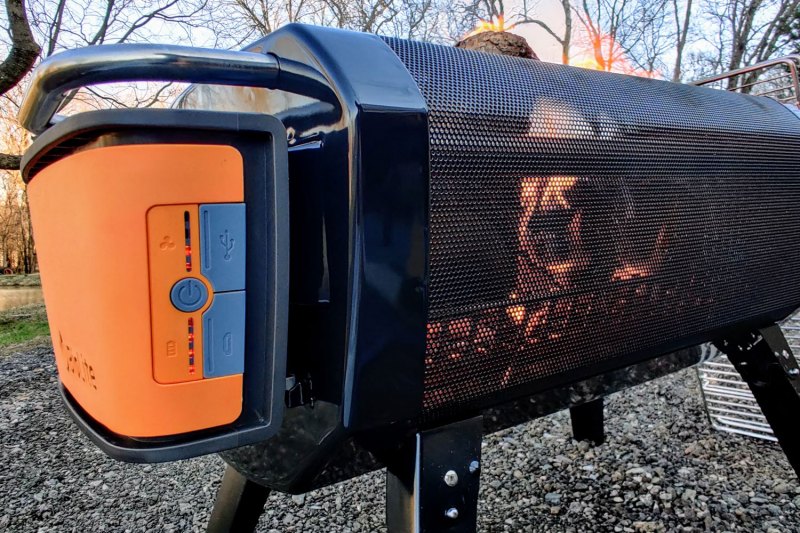
What Is the BioLite FirePit+?
The BioLite FirePit+ is the latest version of its original FirePit, a portable fire pit designed for any outdoor space where traditional campfires might be inconvenient or even dangerous. It’s a deceptively simple gadget — essentially a compact, black steel mesh cage with collapsible legs and a handle on each end. At roughly two feet long, it’s small enough to stow in a closet when you’re not using it and to toss in the trunk of even the smallest compact car for your next
What separates it from other portable fire rings and fire canisters, however, is the battery-powered fan that attaches to one end. With four adjustable speeds, it delivers forced air through metal tubing integrated into the fire chamber to help feed the flames. Plus, BioLite offers a handful of accessories, including a griddle top, a grill lid, and a prep & grill toolkit, that elevate the FirePit+ beyond “ordinary” fire pit status to become a legit fire-powered camp kitchen tool.
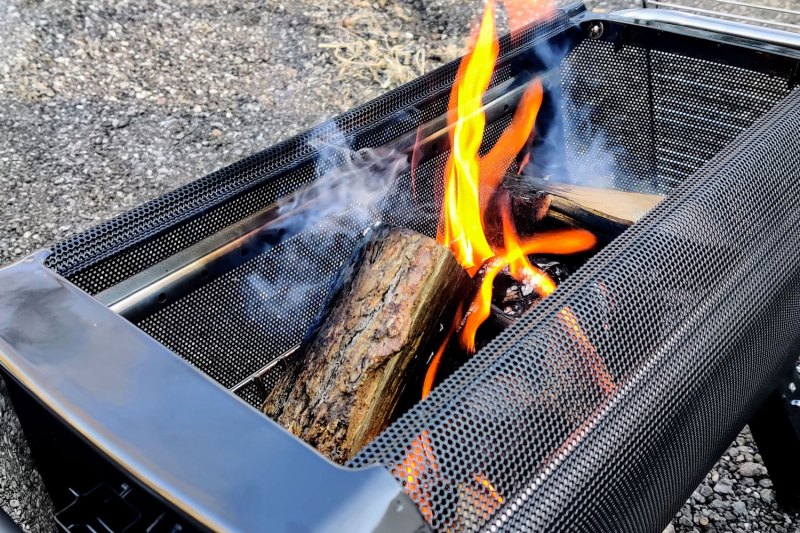
How Does the BioLite FirePit+ Work?
Like other portable fire pits designed for
Using a grill lighter, I started with a golf ball-sized flame inside the FirePit+. Then, I turned the fan on low, heard a quiet gust of air humming through the metal tubing, and the fire immediately started growing. I bumped the fan up to three (its second-highest setting), and the flames sprang to life with zero effort on my part. On its highest setting, the flames shook and danced almost violently, as though a 30 mile-per-hour wind gust had just blown through. I had a solid fire engulfing most of the chamber in less than a minute. Impressive.
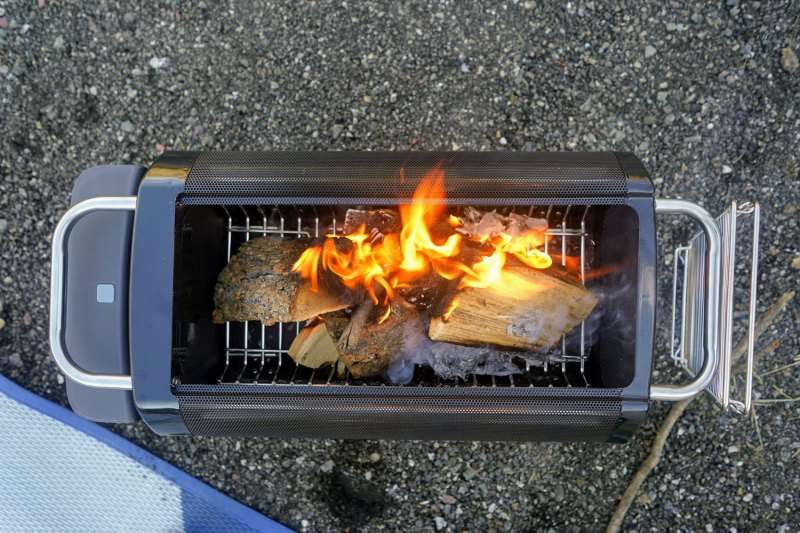
What Are the Features of the BioLite FirePit+?
Although it seems like “just” a steel cage with an attached fan, BioLite’s second-generation FirePit+ packs more features than any portable fire pit I’ve ever tested. Most notably:
- USB rechargeable battery pack: The 12,800mAh battery will keep the fan running for 30 hours on low. It detaches to charge from any standard USB outlet and doubles as a backup battery for charging smaller devices.
- Ultra-portable, compact design: Fully setup, the FirePit+ measures 27 wide x 13 deep by 15.8 inches high (10.5 inches high with the legs folded). It’s large enough to hold standard cordwood yet compact enough not to take up too much space in your garage or apartment.
- Air-jet-powered combustion: 51 air jets line metal tubing integrated into the combustion chamber, all powered by the attached fan. This dramatically improves combustion and helps the fire burn much cleaner with significantly less smoke.
- Hibachi-style grill grate: The included grill grate fits neatly on the top to serve as a cooking surface for meat, fish, veggies, or just about anything else that can be grilled.
- Bluetooth integration: The fan can be controlled via BioLite’s own smartphone app.
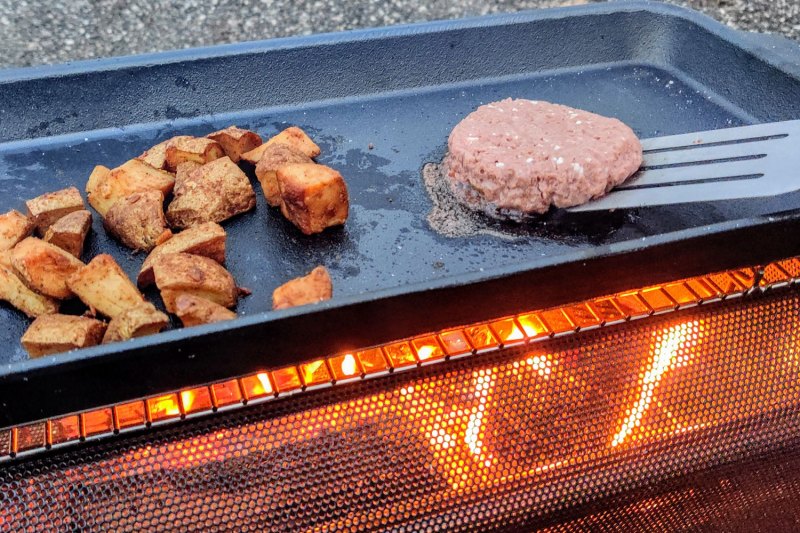
What I Like About the BioLite FirePit+
After a week-long test while
- Compact size: Even though I researched it beforehand, the FirePit+ is smaller and lighter than I expected. For me, that’s a good thing. It’s portable enough to take on trips with my travel trailer and for car camping.
- Durable: While lightweight, it feels well-made and durable enough to survive years of abuse.
- Cooking accessories: The FirePit+ works great as an ordinary fire pit. But, I love the griddle top and lid for a legit grilling experience that’s a clear step above just tossing burgers on a rusty, decades-old campsite grill grate. There’s nothing I can’t cook with it while camping.
- Battery backup: No matter how I’m camping, I always pack a few portable power packs. But, the FirePit+’s additional battery is a nice-to-have backup just in case.
- Easy to control: Two rows of LED lights on the fan indicate the remaining battery power and the fan speed. I like that the fan control button is located right in between these lights, so it’s easy to find in the dark.
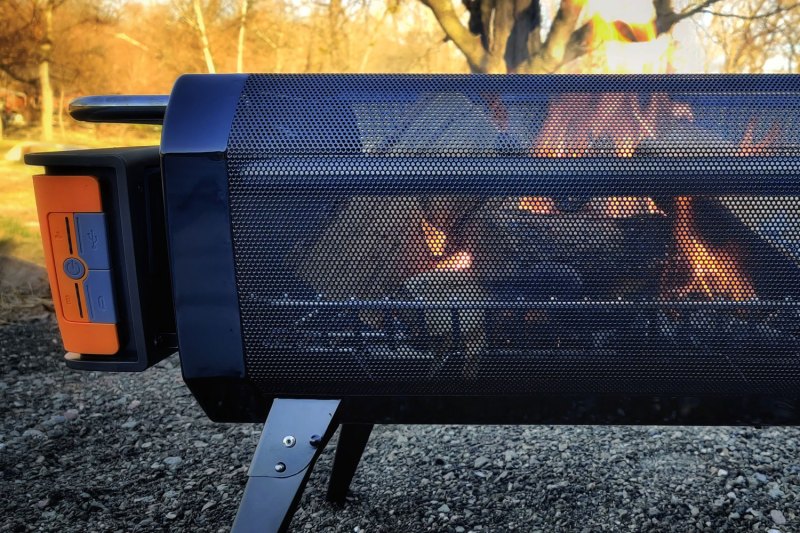
What I Don’t Like About the BioLite FirePit+
- Loud fan: I love the addition of the electric fan. But, on setting 3, it borders on annoying; on setting 4, it’s too loud to run continuously. These higher settings are fine for initially getting the fire going. But, they’re distracting if you’re looking to get that “chilling ‘round the campfire after dark” vibe.
- Smartphone app: I won’t say I dislike the smartphone app. I just find the feature to be a novelty because the fan is so easily controlled with a physical button. By the time I take my phone out of my pocket, launch the app, and confirm the Bluetooth connection is active, I can just as quickly lean out of my camp chair and change the fan speed with the press of a button.
- No carry bag included: I don’t mind having to buy a fancy, premium carry case. But, I wish at least a basic carry bag was included. On my last morning at camp, I realized I had to thoroughly clean out the ash and soot, then wrap the FirePit+ in a large plastic bag I happened to have before stowing it in the back of my SUV. Otherwise, I would’ve wound up with loose ash all over the interior. If you’re considering the FirePit+, I strongly recommend splurging on the FirePit Carry Bag.

FAQs for the BioLite FirePit+
The latest BioLite FirePit+ is a pretty basic camp gadget, but there are a few questions that routinely come up from owners and curious buyers.
Is the BioLite FirePit discontinued?
BioLite discontinued its original FirePit, so it’s no longer available. It’s been replaced by the BioLite FirePit+ (note the “+”).
Where is the BioLite FirePit serial number?
BioLite states that owners can find the serial number for their FirePit+ on the original retail packaging or the battery pack (fan) unit.
Does the Biolite FirePit+ rust?
Any metal exposed to both extreme heat and moisture (often the case if leaving the FirePit+ outside overnight) can develop rust over time. That’s why it’s essential to clean the FirePit+ after every use. BioLite also recommends cleaning the FirePit+ with a soft brush and gentle water and vinegar solution. Repeat as necessary.
Can I use the BioLite FirePit+ indoors?
Absolutely not. On the official website, BioLite explicitly says “no.” It’s intended for outdoor use only.
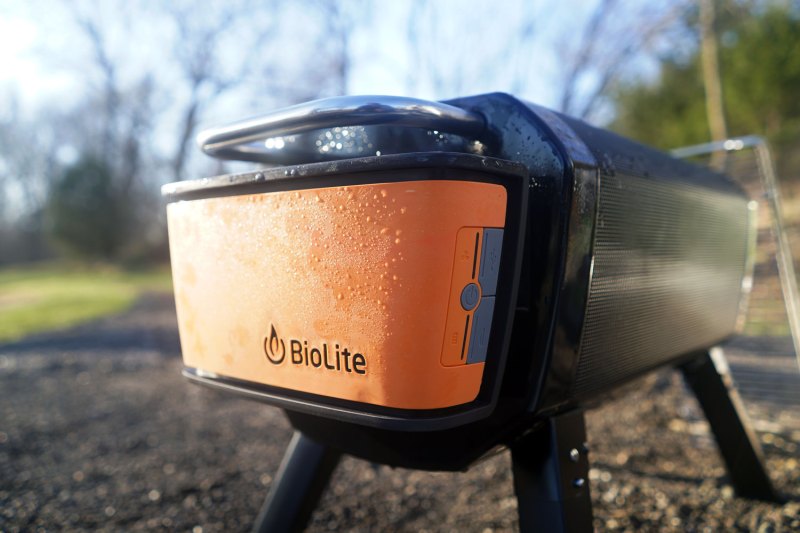
Should You Buy the BioLite FirePit+?
There are plenty of fire pits for campers on the market. At nearly $300 (plus the cost of any accessories), I would consider BioLite’s FirePit+ to be a premium option. But, the addition of an electric fan that makes fire-starting infinitely easier, as well as several great camp cooking accessories, make it well worth the price, in my opinion. It’s my favorite new go-to fire pit for any front-country




